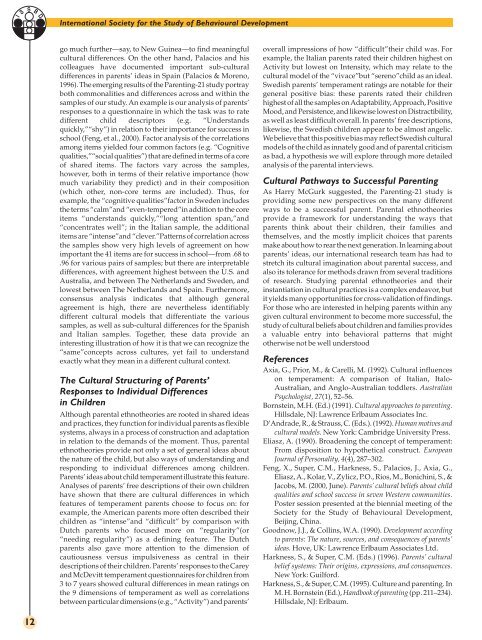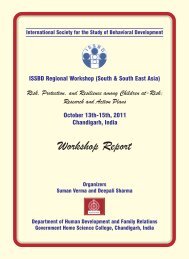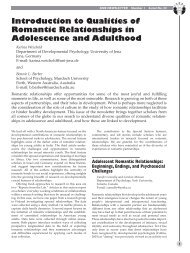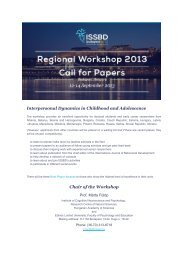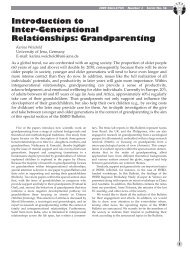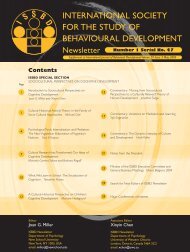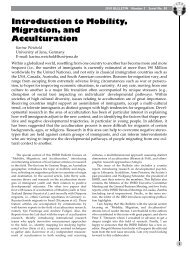Culture and Parenting - International Society for the Study of ...
Culture and Parenting - International Society for the Study of ...
Culture and Parenting - International Society for the Study of ...
Create successful ePaper yourself
Turn your PDF publications into a flip-book with our unique Google optimized e-Paper software.
S<br />
I<br />
S<br />
B<br />
D<br />
<strong>International</strong> <strong>Society</strong> <strong>for</strong> <strong>the</strong> <strong>Study</strong> <strong>of</strong> Behavioural Development<br />
go much fur<strong>the</strong>r—say, to New Guinea—to find meaningful<br />
cultural differences. On <strong>the</strong> o<strong>the</strong>r h<strong>and</strong>, Palacios <strong>and</strong> his<br />
colleagues have documented important sub-cultural<br />
differences in parents’ ideas in Spain (Palacios & Moreno,<br />
1996). The emerging results <strong>of</strong> <strong>the</strong> <strong>Parenting</strong>-21 study portray<br />
both commonalities <strong>and</strong> differences across <strong>and</strong> within <strong>the</strong><br />
samples <strong>of</strong> our study. An example is our analysis <strong>of</strong> parents’<br />
responses to a questionnaire in which <strong>the</strong> task was to rate<br />
different child descriptors (e.g. “Underst<strong>and</strong>s<br />
quickly,”“shy”) in relation to <strong>the</strong>ir importance <strong>for</strong> success in<br />
school (Feng, et al., 2000). Factor analysis <strong>of</strong> <strong>the</strong> correlations<br />
among items yielded four common factors (e.g. “Cognitive<br />
qualities,”“social qualities”) that are defined in terms <strong>of</strong> a core<br />
<strong>of</strong> shared items. The factors vary across <strong>the</strong> samples,<br />
however, both in terms <strong>of</strong> <strong>the</strong>ir relative importance (how<br />
much variability <strong>the</strong>y predict) <strong>and</strong> in <strong>the</strong>ir composition<br />
(which o<strong>the</strong>r, non-core terms are included). Thus, <strong>for</strong><br />
example, <strong>the</strong> “cognitive qualities”factor in Sweden includes<br />
<strong>the</strong> terms “calm”<strong>and</strong> “even-tempered”in addition to <strong>the</strong> core<br />
items “underst<strong>and</strong>s quickly,”“long attention span,”<strong>and</strong><br />
“concentrates well”; in <strong>the</strong> Italian sample, <strong>the</strong> additional<br />
items are “intense”<strong>and</strong> “clever.”Patterns <strong>of</strong> correlation across<br />
<strong>the</strong> samples show very high levels <strong>of</strong> agreement on how<br />
important <strong>the</strong> 41 items are <strong>for</strong> success in school—from .68 to<br />
.96 <strong>for</strong> various pairs <strong>of</strong> samples; but <strong>the</strong>re are interpretable<br />
differences, with agreement highest between <strong>the</strong> U.S. <strong>and</strong><br />
Australia, <strong>and</strong> between The Ne<strong>the</strong>rl<strong>and</strong>s <strong>and</strong> Sweden, <strong>and</strong><br />
lowest between The Ne<strong>the</strong>rl<strong>and</strong>s <strong>and</strong> Spain. Fur<strong>the</strong>rmore,<br />
consensus analysis indicates that although general<br />
agreement is high, <strong>the</strong>re are never<strong>the</strong>less identifiably<br />
different cultural models that differentiate <strong>the</strong> various<br />
samples, as well as sub-cultural differences <strong>for</strong> <strong>the</strong> Spanish<br />
<strong>and</strong> Italian samples. Toge<strong>the</strong>r, <strong>the</strong>se data provide an<br />
interesting illustration <strong>of</strong> how it is that we can recognize <strong>the</strong><br />
“same”concepts across cultures, yet fail to underst<strong>and</strong><br />
exactly what <strong>the</strong>y mean in a different cultural context.<br />
The Cultural Structuring <strong>of</strong> Parents’<br />
Responses to Individual Differences<br />
in Children<br />
Although parental ethno<strong>the</strong>ories are rooted in shared ideas<br />
<strong>and</strong> practices, <strong>the</strong>y function <strong>for</strong> individual parents as flexible<br />
systems, always in a process <strong>of</strong> construction <strong>and</strong> adaptation<br />
in relation to <strong>the</strong> dem<strong>and</strong>s <strong>of</strong> <strong>the</strong> moment. Thus, parental<br />
ethno<strong>the</strong>ories provide not only a set <strong>of</strong> general ideas about<br />
<strong>the</strong> nature <strong>of</strong> <strong>the</strong> child, but also ways <strong>of</strong> underst<strong>and</strong>ing <strong>and</strong><br />
responding to individual differences among children.<br />
Parents’ ideas about child temperament illustrate this feature.<br />
Analyses <strong>of</strong> parents’ free descriptions <strong>of</strong> <strong>the</strong>ir own children<br />
have shown that <strong>the</strong>re are cultural differences in which<br />
features <strong>of</strong> temperament parents choose to focus on: <strong>for</strong><br />
example, <strong>the</strong> American parents more <strong>of</strong>ten described <strong>the</strong>ir<br />
children as “intense”<strong>and</strong> “difficult” by comparison with<br />
Dutch parents who focused more on “regularity”(or<br />
“needing regularity”) as a defining feature. The Dutch<br />
parents also gave more attention to <strong>the</strong> dimension <strong>of</strong><br />
cautiousness versus impulsiveness as central in <strong>the</strong>ir<br />
descriptions <strong>of</strong> <strong>the</strong>ir children. Parents’ responses to <strong>the</strong> Carey<br />
<strong>and</strong> McDevitt temperament questionnaires <strong>for</strong> children from<br />
3 to 7 years showed cultural differences in mean ratings on<br />
<strong>the</strong> 9 dimensions <strong>of</strong> temperament as well as correlations<br />
between particular dimensions (e.g., “Activity”) <strong>and</strong> parents’<br />
overall impressions <strong>of</strong> how “difficult”<strong>the</strong>ir child was. For<br />
example, <strong>the</strong> Italian parents rated <strong>the</strong>ir children highest on<br />
Activity but lowest on Intensity, which may relate to <strong>the</strong><br />
cultural model <strong>of</strong> <strong>the</strong> “vivace”but “sereno”child as an ideal.<br />
Swedish parents’ temperament ratings are notable <strong>for</strong> <strong>the</strong>ir<br />
general positive bias: <strong>the</strong>se parents rated <strong>the</strong>ir children<br />
highest <strong>of</strong> all <strong>the</strong> samples on Adaptability, Approach, Positive<br />
Mood, <strong>and</strong> Persistence, <strong>and</strong> likewise lowest on Distractibility,<br />
as well as least difficult overall. In parents’ free descriptions,<br />
likewise, <strong>the</strong> Swedish children appear to be almost angelic.<br />
We believe that this positive bias may reflect Swedish cultural<br />
models <strong>of</strong> <strong>the</strong> child as innately good <strong>and</strong> <strong>of</strong> parental criticism<br />
as bad, a hypo<strong>the</strong>sis we will explore through more detailed<br />
analysis <strong>of</strong> <strong>the</strong> parental interviews.<br />
Cultural Pathways to Successful <strong>Parenting</strong><br />
As Harry McGurk suggested, <strong>the</strong> <strong>Parenting</strong>-21 study is<br />
providing some new perspectives on <strong>the</strong> many different<br />
ways to be a successful parent. Parental ethno<strong>the</strong>ories<br />
provide a framework <strong>for</strong> underst<strong>and</strong>ing <strong>the</strong> ways that<br />
parents think about <strong>the</strong>ir children, <strong>the</strong>ir families <strong>and</strong><br />
<strong>the</strong>mselves, <strong>and</strong> <strong>the</strong> mostly implicit choices that parents<br />
make about how to rear <strong>the</strong> next generation. In learning about<br />
parents’ ideas, our international research team has had to<br />
stretch its cultural imagination about parental success, <strong>and</strong><br />
also its tolerance <strong>for</strong> methods drawn from several traditions<br />
<strong>of</strong> research. <strong>Study</strong>ing parental ethno<strong>the</strong>ories <strong>and</strong> <strong>the</strong>ir<br />
instantiation in cultural practices is a complex endeavor, but<br />
it yields many opportunities <strong>for</strong> cross-validation <strong>of</strong> findings.<br />
For those who are interested in helping parents within any<br />
given cultural environment to become more successful, <strong>the</strong><br />
study <strong>of</strong> cultural beliefs about children <strong>and</strong> families provides<br />
a valuable entry into behavioral patterns that might<br />
o<strong>the</strong>rwise not be well understood<br />
References<br />
Axia, G., Prior, M., & Carelli, M. (1992). Cultural influences<br />
on temperament: A comparison <strong>of</strong> Italian, Italo-<br />
Australian, <strong>and</strong> Anglo-Australian toddlers. Australian<br />
Psychologist, 27(1), 52–56.<br />
Bornstein, M.H. (Ed.) (1991). Cultural approaches to parenting.<br />
Hillsdale, NJ: Lawrence Erlbaum Associates Inc.<br />
D’Andrade, R., & Strauss, C. (Eds.). (1992). Human motives <strong>and</strong><br />
cultural models. New York: Cambridge University Press.<br />
Eliasz, A. (1990). Broadening <strong>the</strong> concept <strong>of</strong> temperament:<br />
From disposition to hypo<strong>the</strong>tical construct. European<br />
Journal <strong>of</strong> Personality, 4(4), 287–302.<br />
Feng, X., Super, C.M., Harkness, S., Palacios, J., Axia, G.,<br />
Eliasz, A., Kolar, V., Zylicz, P.O., Rios, M., Bonichini, S., &<br />
Jacobs, M. (2000, June). Parents’ cultural beliefs about child<br />
qualities <strong>and</strong> school success in seven Western communities.<br />
Poster session presented at <strong>the</strong> biennial meeting <strong>of</strong> <strong>the</strong><br />
<strong>Society</strong> <strong>for</strong> <strong>the</strong> <strong>Study</strong> <strong>of</strong> Behavioural Development,<br />
Beijing, China.<br />
Goodnow, J.J., & Collins, W.A. (1990). Development according<br />
to parents: The nature, sources, <strong>and</strong> consequences <strong>of</strong> parents’<br />
ideas. Hove, UK: Lawrence Erlbaum Associates Ltd.<br />
Harkness, S., & Super, C.M. (Eds.) (1996). Parents’ cultural<br />
belief systems: Their origins, expressions, <strong>and</strong> consequences.<br />
New York: Guil<strong>for</strong>d.<br />
Harkness, S., & Super, C.M. (1995). <strong>Culture</strong> <strong>and</strong> parenting. In<br />
M. H. Bornstein (Ed.), H<strong>and</strong>book <strong>of</strong> parenting (pp. 211–234).<br />
Hillsdale, NJ: Erlbaum.<br />
12


